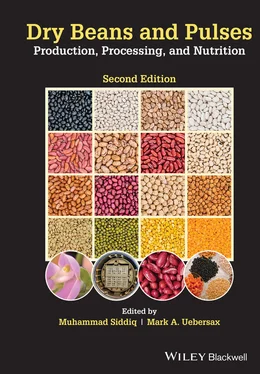Dry Beans and Pulses Production, Processing, and Nutrition
Здесь есть возможность читать онлайн «Dry Beans and Pulses Production, Processing, and Nutrition» — ознакомительный отрывок электронной книги совершенно бесплатно, а после прочтения отрывка купить полную версию. В некоторых случаях можно слушать аудио, скачать через торрент в формате fb2 и присутствует краткое содержание. Жанр: unrecognised, на английском языке. Описание произведения, (предисловие) а так же отзывы посетителей доступны на портале библиотеки ЛибКат.
- Название:Dry Beans and Pulses Production, Processing, and Nutrition
- Автор:
- Жанр:
- Год:неизвестен
- ISBN:нет данных
- Рейтинг книги:5 / 5. Голосов: 1
-
Избранное:Добавить в избранное
- Отзывы:
-
Ваша оценка:
- 100
- 1
- 2
- 3
- 4
- 5
Dry Beans and Pulses Production, Processing, and Nutrition: краткое содержание, описание и аннотация
Предлагаем к чтению аннотацию, описание, краткое содержание или предисловие (зависит от того, что написал сам автор книги «Dry Beans and Pulses Production, Processing, and Nutrition»). Если вы не нашли необходимую информацию о книге — напишите в комментариях, мы постараемся отыскать её.
The second edition of the most complete and authoritative reference on dry beans production, processing, and nutrition available Dry Beans and Pulses: Production, Processing, and Nutrition
Dry Beans and Pulses: Production, Processing, and Nutrition, Second Edition
Dry Beans and Pulses Production, Processing, and Nutrition — читать онлайн ознакомительный отрывок
Ниже представлен текст книги, разбитый по страницам. Система сохранения места последней прочитанной страницы, позволяет с удобством читать онлайн бесплатно книгу «Dry Beans and Pulses Production, Processing, and Nutrition», без необходимости каждый раз заново искать на чём Вы остановились. Поставьте закладку, и сможете в любой момент перейти на страницу, на которой закончили чтение.
Интервал:
Закладка:
2 dietary folate equiv.;
3 as α‐tocopherol;
4 as phylloquinone
A diet high in beans can potentially reduce the risk of developing a chronic disease (Wu et al. 2004). Chronic diseases are conditions that typically take many years (10–30 years) to develop and include certain types of cancers, type‐2 diabetes mellitus, heart disease, and other diseases of the blood system. These diseases are the most common causes of death in the United States and many other parts of the world (Geil and Anderson 1994; Hangen and Bennink 2002). Legumes elicit the lowest blood glucose response as compared to cereal grains. The inclusion of dry beans or other pulses in the daily diet has many beneficial effects in controlling and preventing various metabolic diseases such as diabetes mellitus, coronary heart disease, and colon cancer (Dilis and Trichopoulou 2009; Raju and Mehta 2009; Hayat et al. 2014; Kamboj and Nanda 2018).
Antioxidants – chemicals that destroy free radicals – are found to be very high in many types of beans. Wu et al. (2004) investigated the oxygen radical absorbance capacity (ORAC) of over 100 common foods consumed in the US. Their data showed that red kidney beans had the highest total antioxidant capacity per serving size as compared to all other foods, including many fruits and vegetables. Among all the foods analyzed in that USDA study, dry beans (small red, red kidney, pinto, and black beans) were found to have high levels of antioxidants. Generally, anthocyanin‐rich fruits, such as blueberries and plums, are associated with having higher antioxidant content; however, the above three types of beans were found to have higher antioxidant capacity than even blueberries. It is noted that the ORAC data for dry beans is for uncooked seeds – cooking or canning can result in significant losses of antioxidant capacity.
The potential protective effects of dry beans in disease prevention, such as against cancer, may not be entirely associated to dietary fiber, but to phenolics and other non‐nutritive compounds (Oomah et al. 2006), which can act as antioxidants, thereby hindering the formation of free radicals (Boateng et al. 2008). In addition, legumes belong to the food group that elicits the lowest blood glucose response. The large amount of water‐soluble fiber is particularly effective in lowering cholesterol in the blood, whereas the water‐insoluble fiber provides bulk, pushing food through the digestive system at a faster rate. Common beans are low in sodium (Buttriss and Stokes 2008), so this could be a healthy food choice for persons on a low‐sodium diet.
Beans and pulses use in weaning foods
Malnutrition is prevalent in many regions of the world, often leading to stunting and wasting. Globally, 45% of 5.9 million deaths in children 5 years and under in 2015 were directly linked to malnutrition. Moreover, the malnutrition also significantly retards childhood growth (UNICEF, 2015). Therefore, nutritionally balanced weaning food must provide all the essential nutrients to meet young children’s dietary needs. Generally, plant‐based foods (including legumes) are used to meet the protein needs of infants and preschool children (Kumari and Sangeetha 2017; Borbi et al. 2020).
Dry beans and other pulses, due their nutrient‐dense nature, serve as an important base for weaning foods. The use of appropriate preparation techniques (such as soaking/cooking, dehulling, fine grinding, roasting whole beans, germination, and fermentation) has been found to improve digestibility and reduce flatus from beans and pulses (Donangelo et al. 1995; Twum et al. 2015). The United Nations’ WHO/FAO has detailed guidelines for preparation and use of weaning foods. Further, numerous US public‐ and private‐sector groups (e.g., USDA, USAID, Gates Foundation) have made significant impact in developing weaning food mixes and guideline.
CONSTRAINTS TO UTILIZATION OF BEANS AND OTHER PULSES
A number of factors limit the use of beans and other pulses, including long soaking and cooking times necessary to adequately soften the beans, loss of valuable nutrients during bean preparation, low levels of the sulfur amino acids, low digestibility of unheated proteins, presence of antinutrients (e.g., lectins, trypsin inhibitors), high levels of phytic acid, various flatulence factors, and hard‐to‐cook (HTC) defects (Lucier et al. 2000; Lajolo and Genovese 2002; Uebersax et al. 1989, 1991; Maphosa and Jideani 2017). Table 1.7 presents a summary of constraints associated with legume utilization and possible solutions to minimize negative effects related to each constraint.
Numerous factors influence the quality of the final dry bean product. These include cultivar, seed source, agronomic conditions, handling and storage of the dry product, and processing procedures during cooking or canning. Quality changes in dry beans during cooking and processing are associated with their inherent physical components and chemical constituents (Hosfield and Uebersax 1980; Uebersax 1991). It must be noted that cooking and processing techniques improve the palatability, digestibility, and bioavailability through cellular separation and inactivation of antinutrional components.
Table 1.7. Typical constraints associated with legumes utilization, their negative effects and possible solutions.
Source: Maphosa and Jideani (2017).
| Constraint | Negative effect | Solution |
|---|---|---|
| Trypsin and amylase inhibitors | Decrease protein and starch digestibility | Boiling dry beans generally reduces the content by 80–90% |
| Phytate | Chelates with minerals resulting in poor mineral bioavailability | Dehulling, soaking, boiling, steaming, sprouting, roasting and fermentation, autoclaving, gamma irradiation |
| Lectins, saponins | Reduced bioavailability of nutrients | Most destroyed by cooking, soaking, boiling, sprouting, fermenting |
| Oligosaccharides | Flatulence and bloating | Soaking, cooking, germination, and changing boiling water |
| Hard‐to‐cook phenomenon | Energy and time consumption | Soaking legumes before cooking |
| Low levels of sulfur‐containing amino acids | Incomplete protein source | Consuming in combination with cereals (high in sulfur‐containing amino acids) |
| Low iron bioavailability | Poor source of iron | Consuming in combination with vitamin C rich foods to increase iron absorption |
| Lack of convenient food applications | Boredom of eating the same food repeatedly | New and convenient product development using whole legumes or legume ingredients |
| Lack of awareness and understanding of nutritional benefits of legumes | Low intake of legumes | Increasing consumer awareness of the nutritional and health benefits of legumes |
| Reluctance to try a new food or to change eating habits | Low intake of legumes | Development of innovative, attractive legume‐based products to entice consumers |
A comprehensive assessment of strategies and procedures used for processing dry beans is prerequisite to improved utilization of dry beans. Implementation of a given protocol can be maximized through an understanding of the physical and chemical components, the inherent constraints and diversified processing techniques available to develop economically viable alternative and innovative products (Uebersax et al. 1991). Improved utilization of dry beans can be maximized through an understanding of how physical and chemical components function and react under given process conditions. Further, variability in the physico‐chemical composition of dry beans occurs, warranting research and quality control programs directed to provide a consistent product possessing characteristics of acceptable flavor, bright color, attractive appearance, uniform texture, and high nutritional quality.
Читать дальшеИнтервал:
Закладка:
Похожие книги на «Dry Beans and Pulses Production, Processing, and Nutrition»
Представляем Вашему вниманию похожие книги на «Dry Beans and Pulses Production, Processing, and Nutrition» списком для выбора. Мы отобрали схожую по названию и смыслу литературу в надежде предоставить читателям больше вариантов отыскать новые, интересные, ещё непрочитанные произведения.
Обсуждение, отзывы о книге «Dry Beans and Pulses Production, Processing, and Nutrition» и просто собственные мнения читателей. Оставьте ваши комментарии, напишите, что Вы думаете о произведении, его смысле или главных героях. Укажите что конкретно понравилось, а что нет, и почему Вы так считаете.












